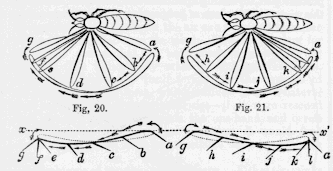Wings
Today, we try to fly on a bee's wings. The University of Houston's College of Engineering presents this series about the machines that make our civilization run, and the people whose ingenuity created them.
In other episodes we look at how crude the wheel is in comparison with walking, or how elementary the airplane is compared to the flight of birds. We've yet to create a two-legged walking machine, flapping-wing flight, or a fin-driven submarine. The motion of living things is too complex. The helicopter is as close as we've come to the flight of birds, and it was so complex we didn't figure it out until 36 years after the airplane.
Now insect paleontologist Robin Wootton talks about insect flight. As a student, he first studied patterns of fossil insect wings etched into stone, hundreds of millions of years old. He knew their beauty reflected a complex functionality, so he set out to understand the mechanics of insect flight.
There's a temptation to think that flying insects were only a primitive step on the way to birds. That error comes from the "ladder of creation" thinking which so misleads us about evolution. We want evolution to be a process that culminated in our creation.
But if we're willing to see ourselves only as a recent splinter in the evolutionary process, then insect flight makes better sense. Insects have been around far longer than we have; they're still here; and they're far more numerous. Evolution has worked out a lot of kinks in that time.
Insect wings have a tough functional delicacy. A membrane, only a micron or so thick, rides on a structure of veins that lets it stretch, bend, or compress. Those wings can change camber, incidence, and area in an instant. If they strike an obstacle they simply bend, then flex back into the right shape.
Insects can hover, turn in one body length, fly right side up or upside down, and land on the ceiling as well as the floor. They are remarkably evolved and far far too sophisticated to copy.
My 1897 Encyclopaedia Britannica article on flight gives 16 pages of analysis of moving birds, insects, and flying fishes -- studies unaided by motion pictures. The article focuses on the hope of recreating their motions to accomplish human flight.
That was six years before the Wright Brothers, and the author was looking to birds and insects for counsel on how to fly. But as he talked about work being done on real flying machines, the futility of copying nature caught up with him. He lamented the inherent rigidity of the machines we were finally being forced to build.
Of course it was in rigid airplanes that we finally did learn to fly, and in which we've flown ever since. Now Wootton goes back to study insects in flight with modern tools. He gives us a lovely article. But it takes on a darker meaning after we open that old Encyclopaedia. For, suddenly, we see that he only reinforces the futility of that century-old dream of imitating nature.
I'm John Lienhard, at the University of Houston, where we're interested in the way inventive minds work.
(Theme music)
Wootton, R. J., The Mechanical Design of Insect Wings. Scientific American, November 1990, pp. 114-120.

The Motion of a Bee's Wings
From the 1897 Encyclopaedia Britannica